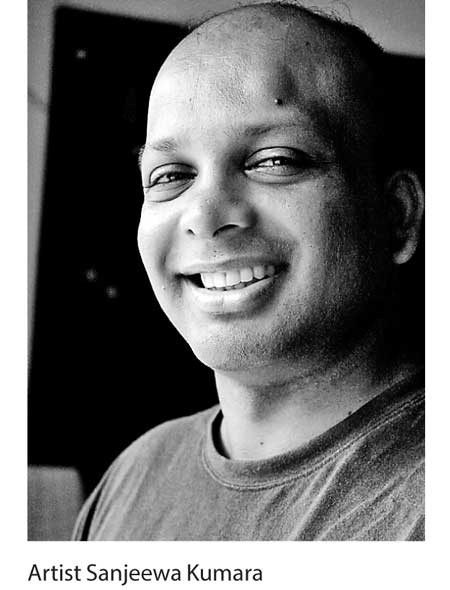Sunday Dec 15, 2024
Sunday Dec 15, 2024
Friday, 19 May 2017 00:00 - - {{hitsCtrl.values.hits}}
 Artist Sanjeewa Kumara will hold his exhibition at Paradise Road Galleries, 02 Alfred House Road, Colombo 03 from 25 May to 14 June from 6 p.m. onwards.
Artist Sanjeewa Kumara will hold his exhibition at Paradise Road Galleries, 02 Alfred House Road, Colombo 03 from 25 May to 14 June from 6 p.m. onwards.
Here are excerpts from an interview with the talented Kumara:
Q: Tell us your inspiration behind these works?
A: In recent years my art works are becoming abundant with flying six-legged elephants, floating hunters, flower paradise, and all sorts of creative creatures, which have made the paintings increasingly colourful. I paint no such paradise. I paint something extremely more difficult: Their echo! As with the great ancient Europeans such as H. Bosch/P. Bruegel, the Elder/Jan van Eyck/Albrecht Dürer/Caravaggio/El Greco/Casper David Friedrich, etc. It is not about the arrival, but the fantasy from paradise.
I make countless references to things disappearing into the depths of space, to the cut off at the edges and to falling out of utensils of a passing time. They are almost ‘moving’ images. When man went to the sky and to the moon, this ‘moving’ feeling came to the painting more than ever. I wanted to create popular iconography moving ‘form’ and space. So I try to synchronise them into an own, unique visual language. I try to re-imagine, re-invent ‘new form/new identity/new landscape. It becomes a self-styled project.
In this project I bring the viewer to a surreal reservoir of images of Sri Lankan history, the furniture of a bygone colonial world, Egyptian art, rococo art, Indian legends, Greek philosophy, planets and space, sea animals, dinosaurs, and secret languages spoken by the painters only. Strange perspectives and changes in existing perspectives, surreal fractures and patterns, and mysteries and antagonisms encode the content of my works and demand the viewer to walk through centuries, while thinking about his own life.
Some set pieces are interwoven with other segments that contradict each chronology or a definite place and demand the radical activation of their own imagination. This is not flirting with the viewer, but it is a very risky exercise.
Q: What is your strongest influence that drives you as an artist?
A: I think it might be my interest in art history and my feeling that I wanted to be part of a line of development of man – from the cave painters 35,000 years ago to the present, people paint. Essentially, we use the same tools – a stick with some hair on the end of it, minerals from the earth mixed with some oil. I love that sense that I’m doing the same thing that people have always done.
Q: Do you draw inspiration from international art practices?
A: Yes, Non-western artists and their works are my biggest influence.
However some of Pre-Renaissance artists and artists like Pieter Brueghel are influence to my works.
Q: What is your advice to aspiring artists of today?
A: My art is a challenge to the western hegemony of art. Mostly local contemporary artists don’t do that.
Mostly they imitate modern and post-modern art without thinking. And not give attention to the cultural landscape of Sri Lanka.
Paradoxically or ironically I cannot move with western art. So I name my art ‘non-western western art’. Art is also about thinking, I believe revolutions are still possible in paintings. I just wanted to be free. Freedom is of enormous importance to an artist as well as to my (art) work.